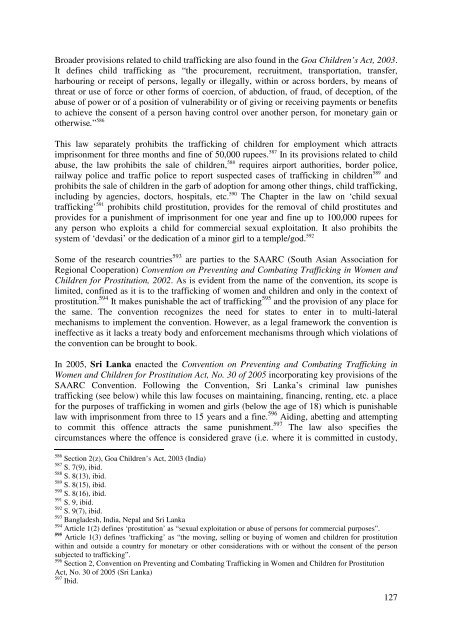SEXUAL HEALTH AND HUMAN RIGHTS A legal and ... - The ICHRP
SEXUAL HEALTH AND HUMAN RIGHTS A legal and ... - The ICHRP
SEXUAL HEALTH AND HUMAN RIGHTS A legal and ... - The ICHRP
Create successful ePaper yourself
Turn your PDF publications into a flip-book with our unique Google optimized e-Paper software.
Broader provisions related to child trafficking are also found in the Goa Children’s Act, 2003.<br />
It defines child trafficking as “the procurement, recruitment, transportation, transfer,<br />
harbouring or receipt of persons, <strong>legal</strong>ly or il<strong>legal</strong>ly, within or across borders, by means of<br />
threat or use of force or other forms of coercion, of abduction, of fraud, of deception, of the<br />
abuse of power or of a position of vulnerability or of giving or receiving payments or benefits<br />
to achieve the consent of a person having control over another person, for monetary gain or<br />
otherwise.” 586<br />
This law separately prohibits the trafficking of children for employment which attracts<br />
imprisonment for three months <strong>and</strong> fine of 50,000 rupees. 587 In its provisions related to child<br />
abuse, the law prohibits the sale of children, 588 requires airport authorities, border police,<br />
railway police <strong>and</strong> traffic police to report suspected cases of trafficking in children 589 <strong>and</strong><br />
prohibits the sale of children in the garb of adoption for among other things, child trafficking,<br />
including by agencies, doctors, hospitals, etc. 590 <strong>The</strong> Chapter in the law on ‘child sexual<br />
trafficking’ 591 prohibits child prostitution, provides for the removal of child prostitutes <strong>and</strong><br />
provides for a punishment of imprisonment for one year <strong>and</strong> fine up to 100,000 rupees for<br />
any person who exploits a child for commercial sexual exploitation. It also prohibits the<br />
system of ‘devdasi’ or the dedication of a minor girl to a temple/god. 592<br />
Some of the research countries 593 are parties to the SAARC (South Asian Association for<br />
Regional Cooperation) Convention on Preventing <strong>and</strong> Combating Trafficking in Women <strong>and</strong><br />
Children for Prostitution, 2002. As is evident from the name of the convention, its scope is<br />
limited, confined as it is to the trafficking of women <strong>and</strong> children <strong>and</strong> only in the context of<br />
prostitution. 594 It makes punishable the act of trafficking 595 <strong>and</strong> the provision of any place for<br />
the same. <strong>The</strong> convention recognizes the need for states to enter in to multi-lateral<br />
mechanisms to implement the convention. However, as a <strong>legal</strong> framework the convention is<br />
ineffective as it lacks a treaty body <strong>and</strong> enforcement mechanisms through which violations of<br />
the convention can be brought to book.<br />
In 2005, Sri Lanka enacted the Convention on Preventing <strong>and</strong> Combating Trafficking in<br />
Women <strong>and</strong> Children for Prostitution Act, No. 30 of 2005 incorporating key provisions of the<br />
SAARC Convention. Following the Convention, Sri Lanka’s criminal law punishes<br />
trafficking (see below) while this law focuses on maintaining, financing, renting, etc. a place<br />
for the purposes of trafficking in women <strong>and</strong> girls (below the age of 18) which is punishable<br />
law with imprisonment from three to 15 years <strong>and</strong> a fine. 596 Aiding, abetting <strong>and</strong> attempting<br />
to commit this offence attracts the same punishment. 597 <strong>The</strong> law also specifies the<br />
circumstances where the offence is considered grave (i.e. where it is committed in custody,<br />
586 Section 2(z), Goa Children’s Act, 2003 (India)<br />
587 S. 7(9), ibid.<br />
588 S. 8(13), ibid.<br />
589 S. 8(15), ibid.<br />
590 S. 8(16), ibid.<br />
591 S. 9, ibid.<br />
592 S. 9(7), ibid.<br />
593 Bangladesh, India, Nepal <strong>and</strong> Sri Lanka<br />
594 Article 1(2) defines ‘prostitution’ as “sexual exploitation or abuse of persons for commercial purposes”.<br />
595 Article 1(3) defines ‘trafficking’ as “the moving, selling or buying of women <strong>and</strong> children for prostitution<br />
within <strong>and</strong> outside a country for monetary or other considerations with or without the consent of the person<br />
subjected to trafficking”.<br />
596 Section 2, Convention on Preventing <strong>and</strong> Combating Trafficking in Women <strong>and</strong> Children for Prostitution<br />
Act, No. 30 of 2005 (Sri Lanka)<br />
597 Ibid.<br />
127

















